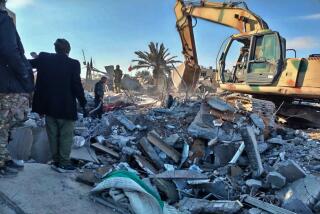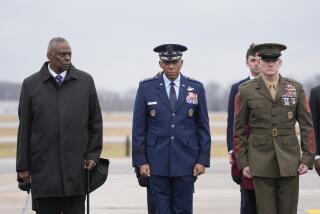U.S. Weaponry in Gulf Is Tough but Not Enough, Arms Experts Say
- Share via
WASHINGTON — Although the missiles and bombs raining down on Iraq represent the largest, most sophisticated U.S. assault since the Persian Gulf War, they may not be enough to accomplish the Clinton administration’s objectives, weapons experts said Thursday.
In sheer volume of weaponry, Washington now has more ships, aircraft and troops in the region than it has assembled anywhere since Operation Desert Storm in 1991--including two aircraft carrier battle groups, hundreds of warplanes and several hundred cruise missiles.
The arsenal also is the most sophisticated the Pentagon has ever wielded: In the Gulf War, only about 8% of all bombs dropped by attack planes were precision-guided “smart bombs,” which have a higher probability of hitting their targets than free-falling varieties. Today, at least 70% of U.S. bombs are precision-guided.
But weapons experts warn that even with those improvements, it’s unlikely that the Clinton administration and its British allies will be able to fulfill their goal of “degrading” Iraq’s military capability if, as top officials have hinted, the attack is limited to a few days.
“It depends what they mean by ‘degrade,’ ” said John Pike, a weapons analyst with the Federation of American Scientists. “With what they’ve got out there now, ‘degrade’ means that every building they target will have a hole in its roof. That’s annoying, but not a disaster. . . . With 1,000-pound bombs in those Tomahawks, they certainly aren’t going to be leveling such facilities.”
He added that air operations would have to be continued “well past Christmas to obliterate Iraq’s special weapons structure.”
There is also a limit on how many cruise missiles the U.S. forces can launch.
The Tomahawks cost about $1 million apiece--expensive for delivering a 1,000-pound warhead--and only about 400 of the newer, precision-guidance models were on hand when the operation began. About 200 were launched Wednesday, the first day of the attack.
As a result, military analysts remain skeptical that the administration will be able to accomplish its objectives of weakening Iraqi President Saddam Hussein’s grip on power and destroying his capacity to develop weapons of mass destruction.
“What they’re doing now is the same thing that we did in Vietnam--sending a message and no more,” said retired Air Force Col. Robert W. Gaskin, a former Pentagon planner. “It never really accomplished anything in Vietnam, and it won’t this time around either.”
To be sure, by any standard the U.S. fighting force now in the Persian Gulf region is formidable. In addition to the two aircraft carrier groups and the Tomahawk missiles, the Pentagon is deploying radar-evading F-117A Stealth fighters and B-52 and B-1 bombers.
It also is assembling several thousand soldiers in Kuwait to help defend that country if Iraqi forces pour across the border, as they did in August 1990. That invasion led to the Gulf War.
The U.S. forces also have new air-launched “penetrator” bombs that can burrow into the earth to blow up underground bunkers and weapons caches.
Even the Tomahawk cruise missiles and Conventional Air-Launched Cruise Missiles being used by the Navy and Air Force are far more advanced than those deployed in 1991.
Back then, the missiles had to follow terrain features to find their targets and were impeded by bad weather. Today, they are guided by satellites.
U.S. forces also are better able to coordinate their attacks. During the Gulf War, the Navy was using a different communications system, requiring the Air Force personnel to hand-carry orders for deploying Navy aircraft to aircraft carriers rather than sending them by computer. Now they can communicate directly.
Knowledge about targets also is far more detailed than it was in 1991. The reports filed by United Nations weapons inspectors working in Iraq--as well as interviews with Iraqis who have escaped to the West in recent years--have provided a wealth of information.
All this makes it easier for U.S. attackers to pick out the most crucial targets and guide weapons to them than during the Gulf War.
As a result, the current arsenal will be able to wreak more damage than a comparable assemblage would have accomplished at the start of the 1991 operation, said Bryan Bender, Washington bureau chief of Jane’s Defense Weekly, which monitors weapons developments.
“They can definitely put a fairly good dent in Saddam’s operations,” Bender said.
The results of the improved technology were shown off by the Pentagon on Thursday.
Army Gen. Henry H. Shelton, chairman of the Joint Chiefs of Staff, showed reporters aerial photographs of two Iraqi military buildings that had been leveled by U.S. cruise missiles.
“You don’t see anything but rubble [in place of] what formerly was this building,” he said.
He also showed photographs of a U.S.-bombed Iraqi barracks in which four out of the five buildings involved were destroyed.
However, Pike, the analyst at the Federation of American Scientists, argued that such complete devastation will not prove the rule, even with the improved technology.
“They’re telling us they hope to ‘degrade’ Iraq’s capability because they know they can’t say they hope to ‘eliminate’ it,” he said.
(BEGIN TEXT OF INFOBOX / INFOGRAPHIC)
Night Vision
Illuminating the dark with an eerie green glow, night vision technology allows viewers to see objects at night. Such night scopes are being used for surveillance during the nighttime strikes in Iraq.
1) Objective lens: Collects light invisible to the naked eye
2) Photocathode: Converts light energy into electrons
3) Microchannel plate: Multiplies electrons
4) Phosphor screen: Receives intensified electron image, emits visible light
5) Collimator: Straightens light beams
Source: Night Quest
More to Read
Sign up for Essential California
The most important California stories and recommendations in your inbox every morning.
You may occasionally receive promotional content from the Los Angeles Times.













